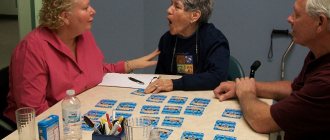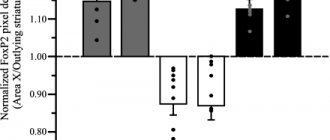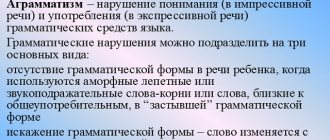Forms of aphasia
In the first days after a cerebrovascular accident, speech disorders in patients may manifest themselves in the form of total aphasia
: the patient does not speak and does not understand speech addressed to him.
Total aphasia after a few days or weeks may be replaced by sensory
or
motor aphasia
: the patient begins to understand speech addressed to him, but communicates with others using a speech “embolus” - a stereotypically repeated sound combination, syllable or word, sometimes well intoned.
There are several forms of aphasia
However, two main
forms of aphasia
:
- sensory
- motor
Aphasia after stroke and more
Aphasia is most common in older people who have had a stroke
. However, speech destruction occurs in young people and even in children who have suffered infectious diseases, traumatic brain injuries, or brain tumors. The form of aphasia depends on which part of the brain is affected. And the direction in which speech restoration specialists will work depends on the form.
Diagnosis of aphasia
Experts from different fields are involved in uncovering the mechanisms of this complex disease: neurophysiologists, neurologists, speech therapists, psychologists, etc. The diagnosis is made after the localization of the lesion in the brain has been determined. The complexity of the disorder depends on the size of the lesion, the nature of the circulatory disorder and the characteristics of the intact components of speech activity.
It is known that the highest mental functions of a person are carried out as a result of the work of the cortex of the two hemispheres of the brain and its subcortical structures. Aphasia is caused by damage to the dominant hemisphere, the right in left-handed people and the left in right-handed people.
This is how the frontal lobes of the cortex carry out programming, regulation of mental activity and correction of its results. The right frontal lobe carries out non-speech actions, the left is responsible for the movement of the tongue and the entire body, plans speech and mental activity, and predicts its impact on the situation. The temporal lobes of the cortex are responsible for listening and understanding speech. The right temporal lobe captures and differentiates non-speech sounds, the left is responsible for the perception of both individual sounds of language and their synthesis into groups of words. The occipital lobes of the cortex perform the functions of collecting and processing information through vision, the parietal lobes - through the tactile-kinesthetic sense.
Diagnosis of the activity of cerebral cortex functions in aphasia is carried out in the following areas:
|
Up
Main forms of aphasia
There are several classifications of aphasia; in our country, the classification of A.R. is widespread. Luria, abroad – Lichtheim-Wernicke classification. There is also a simplified classification: posterior form of aphasia - damage to the superior temporal and inferior parietal areas of the brain, and anterior form - damage to the posterior frontal regions. Classic descriptions examine not only lesions of the speech areas of the brain, but also adjacent non-speech areas of the cortex.
Features of the development of aphasia are different. In cases of circulatory disorders and brain injuries, speech disorder occurs sharply and immediately. With sluggish circulatory disorders and gradual growth of a brain tumor, the symptoms of aphasia appear slowly, as the brain zones are covered.
Sensory aphasia
Wernicke's sensory aphasia
is a violation of the understanding of speech, both someone else’s and one’s own, while maintaining the ability to speak.
Occurs when the left temporal lobe of the brain is damaged. As a rule, the patient speaks quite willingly and a lot, but due to the loss of understanding of what he hears, he does not understand either himself or those around him. The form of sensory aphasia
is characterized by two main features:
- the patient’s speech is incomprehensible to others due to the lack of meaning in it (misunderstanding of one’s own speech leads to loss of control over it, the patient invents new words, replaces letters or syllables in existing ones, swaps words, pronounces incoherent strings of words and sentences)
- the speech of others and his own is incomprehensible to the patient (due to impaired perception of sound, loss of distinction in the sound composition of words, the patient does not understand the meaning of what he hears)
Motor aphasia
Broca's motor aphasia
is a violation of the ability to speak while maintaining the ability to understand speech. Occurs when the frontal lobe of the brain (Broca's motor speech center) is damaged. The patient has difficulty pronouncing or does not pronounce words, mainly pronouncing simple words or syllables. The main features of the form of motor aphasia are:
- the patient’s speech is poorly distinguishable, but is often understandable and meaningful, accompanied by eloquent gestures (the patient has difficulty pronouncing and moving from one word to another)
- the speech of others is well understood by the patient
Causes of aphasia
Speech dysfunction is associated with changes that occur in the main organ of the central nervous system (when a person’s speech has already fully formed). There are many reasons that contribute to the development of the disease. Among the most common are:
- strokes (hemorrhagic or ischemic). It is important to note that people who have had a hemorrhagic stroke are diagnosed with a total or mixed syndrome, and people who have had an ischemic stroke are diagnosed with a motor or sensory form;
- traumatic brain injury – mechanical damage to the skull and intracranial formations (in particular, the brain, meninges, blood vessels). These include bruises (contusions), compression (compression) and concussion;
- inflammatory brain diseases (in particular, encephalitis, abscess);
- brain tumors;
- pathologies of the central nervous system;
- previous surgical interventions on the brain.
In addition, experts distinguish many factors that significantly increase the risk of developing speech impairment.
Treatment of aphasia
Treatment of aphasia
in most cases it is successful. There are special speech restoration programs for different forms of aphasia, which are differentiated. In the process of individual work with patients with aphasia, a speech therapist modifies the techniques and methods of correctional pedagogical work available in the arsenal of defectology, bringing his own individual experience.
Treatment of aphasia
consists not only in restoring ability, but also in restoring the affected part of the brain, which is the cause of the speech disorder.
If you or your loved ones have speech problems, make an appointment with a speech therapist. At the “Your Health” clinic, appointments are conducted by a highly qualified specialist with many years of experience in the specialty “Speech Therapy” Ella Borisovna Rothbert, who will help you choose the optimal method of speech correction.
There are several forms of aphasia, which are characterized by a violation of either speech understanding or speech reproduction. In severe cases of aphasia, a person’s ability to both understand others and speak is impaired. This speech disorder most often occurs in older people as a consequence of severe brain diseases (stroke, tumors) or brain injuries.
In children, aphasia is diagnosed when organic brain damage occurs after the child has mastered speech. In this case, aphasia leads to disruption of its further development, sometimes to the collapse of formed speech. Aphasia often leads to profound disability.
The possibilities for compensation for speech and mental disorders in children and adults are sharply limited. Adults with aphasia, as a rule, lose their profession and have difficulty adapting to everyday life. Misunderstanding of others and the inability to express one’s desires cause behavioral disorders: aggression, conflict, irritability.
2.3. Classification of aphasias
Difficulties that have arisen in aphasiology (mismatch between theoretical concepts of aphasia, their classifications and clinical facts, etc.) required a new approach to the study of aphasia. A new period of development was laid by Soviet researchers. The neuropsychological study of aphasia, begun by A. R. Luria and his colleagues, made it possible to qualify the defect and establish the mechanism of the disorder underlying the speech defect. A. R. Luria created a new doctrine of aphasia, which was based on the idea of aphasia as a systemic speech disorder that arises as a result of the loss of any one factor (kinetic or kinesthetic analysis of sounds, phonemic hearing, spatial concepts, etc.) and leading each time to a specific syndrome (symptom complex), characteristic of one or another form of aphasia. This “factorial” approach, developed by A. R. Luria, was the basis for his classification of aphasias, which is fundamentally different from the classical classification of aphasias and modern foreign ones. This approach to aphasia is essential to the effectiveness of remedial training.
A. R. Luria’s identification of different forms of aphasia was based on the “principle of analysis of topically limited brain lesions,” on the one hand, and “the identification of those factors that underlie the entire complex of disorders that occur with local brain lesions,” on the other . Since the psychophysiological basis of speech is the joint activity of various analyzers and the interaction of various levels of the nervous system, it is natural that the loss of various links (or factors) from the structure of speech will be accompanied by various forms of its disorders, i.e. various forms of aphasia. All forms of aphasia differ significantly from each other in the underlying mechanism, in the clinical picture and in the psychological structure of the speech disorder. Common to all forms of aphasia is a systemic disorder of speech, and not an isolated loss of any aspect of it. Each form of aphasia occurs when a certain area of the cortex of the left hemisphere of the brain, the so-called “speech zone,” is damaged, and depends on the location of the lesion and the factor.
The classification of aphasias developed by A. R. Luria differs from the classical Wernicke-Lichtheim and modern foreign ones (“fluent” and “non-fluent” aphasias - fluent and nonfluent aphasia (Howes, 1964; Venson, \967; Goodglass, 1968); disconnection syndroms {Goodglass, Benson, etc.), expressive and receptive aphasia {Lhermitte et al.)), firstly, by the fact that the main principle of identifying the form of aphasia is the principle of isolating the mechanism (factor) underlying the violation of the functional system that provides speech . Secondly, syndromic analysis of the disorder replaced a simple description of the external picture of the disorder. Let us turn to the description of the classification of aphasia created by A. R. Luria. He studied and described seven forms of aphasia:
- efferent motor aphasia (damage to the posterior frontal parts of the cerebral cortex - 44th field, or Broca's area);
— afferent motor aphasia (damage to the posterior postcentral sections of the motor analyzer, lower parietal sections);
- dynamic aphasia (brain areas located anterior to Broca’s area and additional speech “Penfield area”);
- sensory aphasia (damage to the posterior third of the superior temporal gyrus - 22nd area, Wernicke's area);
- acoustic-mnestic aphasia (damage to the middle temporal gyrus - 21st and 37th fields);
— semantic aphasia (damage to the parietal-temporal-retro-occipital region);
- amnestic aphasia (posterior temporal and parieto-occipital areas of the cortex of the left hemisphere of the brain).
In recent years of our experimental and practical work with patients with aphasia, we have made an attempt to approach the classification of aphasia based on a new principle for considering and understanding aphasia. The experimental material we obtained together with A. A. Tsyganok (1973), and later in our theoretical-experimental work (1998,2002), gave grounds to apply a level approach to the analysis and understanding of aphasia. Here the question was considered at what level in the structure of speech the disturbances occurred and to what level of damage they correspond. We received data indicating that dynamic, semantic and amnestic forms of aphasia, in which higher syntheses in the flow of speech are disrupted, fall into one group. Acoustic-mnestic aphasia joins them. As for their brain basis, these are also the highest levels in the structure of the cortex - tertiary fields.
The second group includes afferent and efferent motor and sensory forms of aphasia, which are a consequence of violations of lower levels in the construction of speech, levels that provide sensory perception and lower forms of motor processes. The brain basis of these forms of aphasia is a violation of secondary fields in the structure of the cerebral cortex.
brain and aphasia (continued) – Previous / Next – 2.3. classification of aphasias









